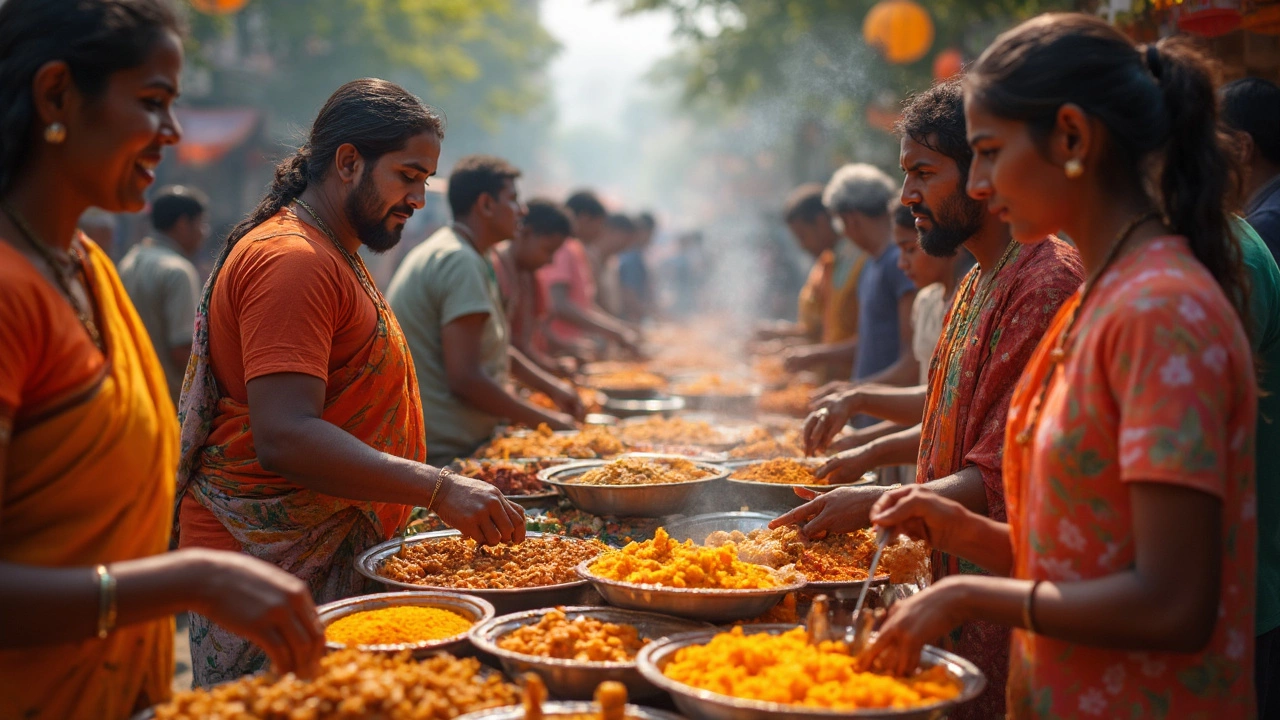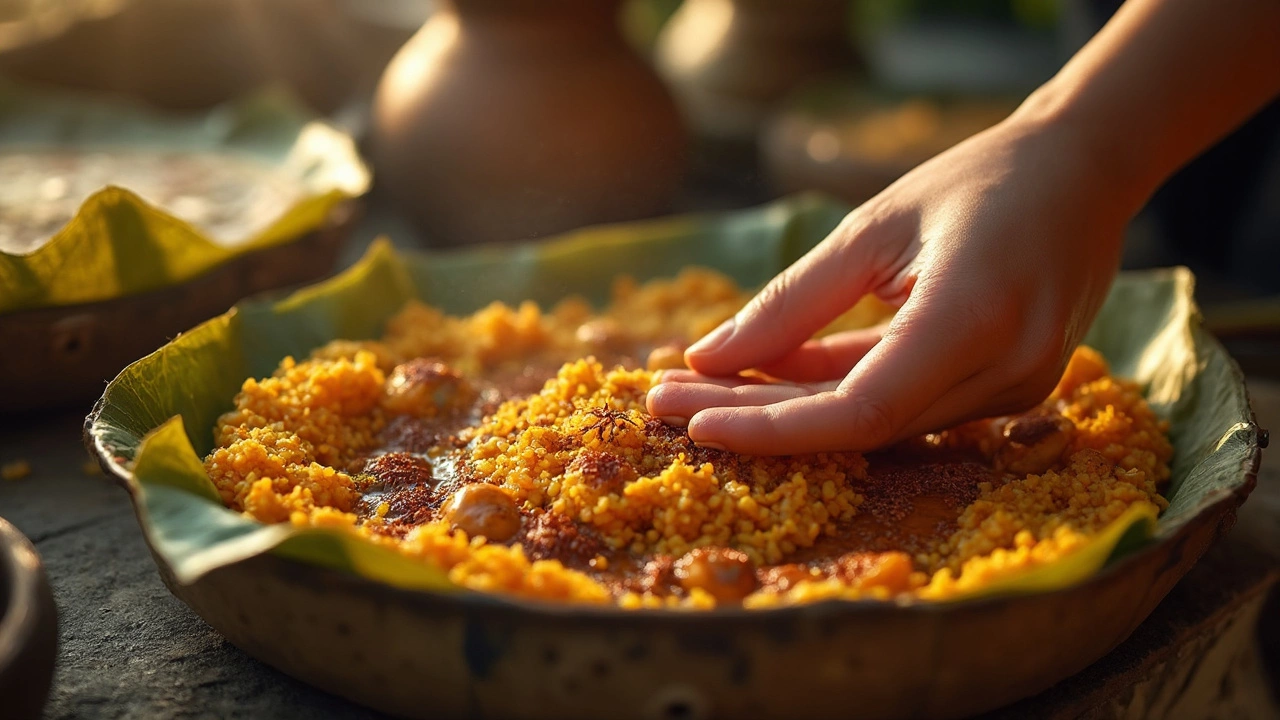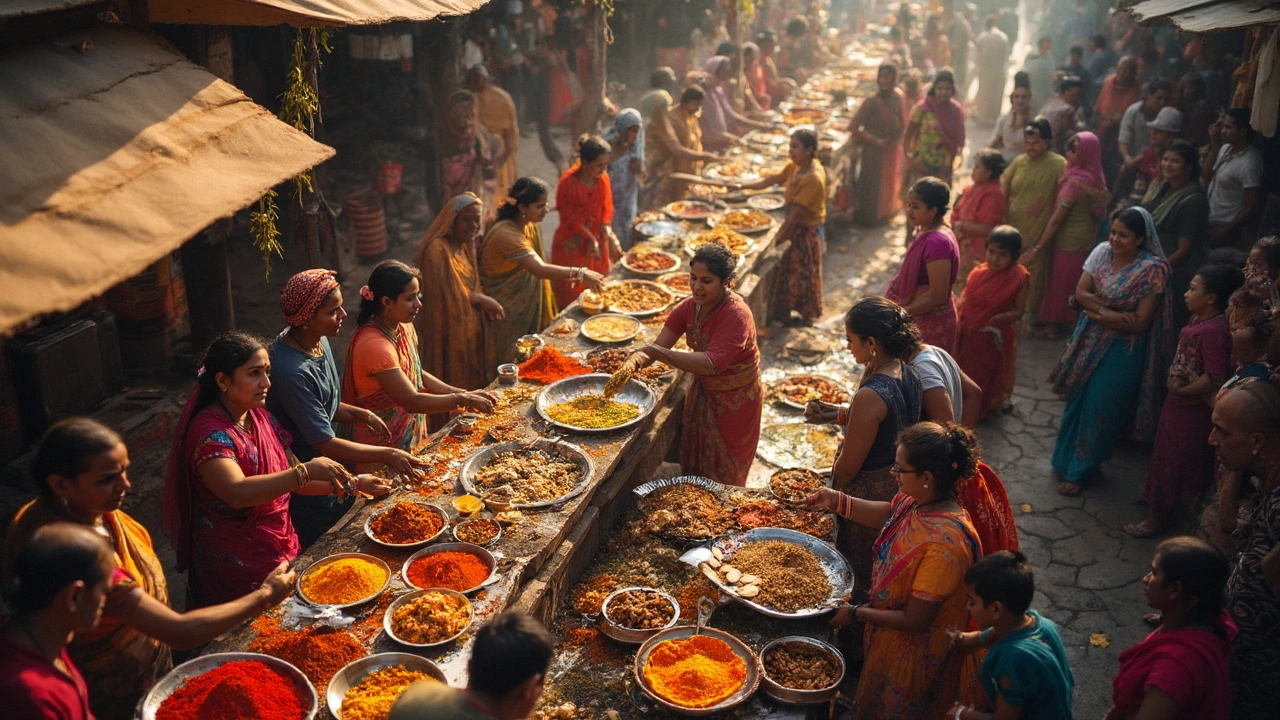Why Indian Street Food is Served by Hand
 Apr, 3 2025
Apr, 3 2025
Have you ever wondered why Indian street vendors prefer using their hands instead of utensils? It might seem unusual if you're not from here, but there's a whole lot more to it than just convenience. In India, using hands to eat is not just common; it's a deeply ingrained cultural practice that goes way back.
First off, let’s talk about the cultural significance. In many Indian households, eating with hands is a tradition passed down through generations. It’s believed to connect you more with the food, making the eating experience more fulfilling. And when it comes to street food, this tradition naturally extends to how vendors prepare and serve food.
- Cultural Significance of Using Hands
- Practicality in Street Food Setup
- Enhancing the Flavor Experience
- Hygiene and Safety Considerations
- Personal Touch in Food Interaction
Cultural Significance of Using Hands
Eating with hands is more than a habit in India; it's a tradition that offers a peek into the country's rich cultural tapestry. When you think about Indian street food, the image of vibrant, bustling stalls and vendors skillfully preparing tasty delights with their hands comes to mind. But why exactly do they do this?
In Indian culture, eating is seen as a sensory experience that goes beyond just tasting. Using hands while eating is believed to involve all the senses, heightening the flavors and connecting people to their food. It's not just about feeding the body but also nourishing the soul. This method of eating is said to have roots in Ayurveda, an ancient Indian health science, which suggests that being in contact with the food improves digestion and overall wellness.
Additionally, the act of eating with hands fosters a sense of community and sharing. Whether it’s in the bustling streets of Mumbai or the vibrant markets of Delhi, using hands signifies breaking down the barriers that cutlery often creates. It’s a more personal way of sharing meals, inviting others to partake in a common experience.
On a broader level, the food culture in India values humility and communal ties. Eating with hands embodies a spirit of equality and togetherness, emphasizing that everyone is the same at the dining table.
There's even a practical side to this tradition. You can easily feel the temperature and texture of the food, reducing the risk of burning your mouth with food that's too hot. It's these small yet impactful reasons that make the practice of eating with hands so ingrained in the Indian lifestyle.
Practicality in Street Food Setup
When you're hustling at an Indian street food stall, every second counts. Vendors need to keep the line moving, especially during peak hours when the aroma of samosas and chaat draws in a hungry crowd. Using hands becomes the most efficient way to handle food quickly and effectively.
Handling small portions, like the spicy lentil balls in pani puri or the tangy chutneys that accompany so many Indian snacks, can be quite tricky with tools. Hands allow vendors to precisely control portion sizes and assemble intricate dishes on the fly without missing a beat.
Interestingly, a renowned chef from Mumbai once said,
"Hands are the original kitchen tools. There's no better way to get the right texture and flavor in dishes as diverse as Indian street food."This insight highlights how hands-on techniques have been vital to street food culture.
Another key reason is heat measurement. When the food is piping hot, using hands gives vendors a tactile sense of when it's ready to be handed over to you, balancing safety and speed seamlessly.
It's also about multitasking. Think about a vendor preparing a dosa – the expert swirl of batter, the swift dabbing of oil, and the quick flip of the spatula for serving, all performed while tending to other orders. Hands help orchestrate this well-timed culinary dance smoothly.
| Task | Time Saved |
|---|---|
| Scooping chole for chaat | 30 seconds |
| Filling and serving pani puris | 15 seconds |
| Handling chatpati items | 20 seconds |
So, the next time you grab a bite from an Indian street food vendor, remember that using hands isn't just a tradition—it's a practical, time-tested solution that keeps the flavorful experience fast and efficient.

Enhancing the Flavor Experience
When it comes to indulging in Indian street food, using hands isn’t just a quirky choice; it can actually heighten your flavor experience. It’s like diving into food with an extra sense engaged. Feeling the texture before a bite makes the whole experience richer, right from the moment you touch the food.
One big reason is that our hands are temperature-sensitive tools. No metal or plastic utensils can beat the finesse of fingers when it comes to feeling the right hotness of a freshly baked samosa or a steaming dosa. By just touching the food, you know if it’s too hot to handle or ready to devour, which means no burned tongues or wasted bites!
Another thing is that eating with your hands enhances the aroma and flavors. Isn’t it exciting when you scoop up some spicy chaat or fragrant biryani? It’s a dance between fingers and senses, getting those taste buds prepped with every stir and scoop.
Plus, ever noticed how the mix of flavors seems more balanced? Think about eating a classic Indian thali. The rice, the curry, the pickles, and chutneys — blending them just right needs that personal touch. Mixing them by hand ensures each bite has the perfect mix of flavors, making your meal truly delightful.
You might hear folks say, "Oh, eating with hands isn't hygienic," but Indian street vendors have this down to a science. There’s a whole protocol of washing hands before and during meal prep. Also, there’s something so genuine about having food served with a personal touch, isn’t there?
Hygiene and Safety Considerations
When it comes to street food, hygiene is a huge deal. You might think, why would anyone use their hands? Isn't that less hygienic? Well, let’s break it down. First things first—many vendors are quite particular about cleanliness. You'll often see street food sellers washing their hands regularly, even if the setup is small and busy.
Hygiene practices are closely linked to the flavor experience and practicality. In the bustling atmosphere of a street food setting, using hands can actually prevent the spread of contaminants that could come from shared utensils. Serving food by hand also allows workers to feel the food’s temperature and texture, making it easier to manage safe serving practices.
Additionally, some stalls even use a simple yet effective method to minimize contamination—wearing disposable gloves or using sanitizer frequently. This ensures that while the tradition of eating with hands is respected, modern hygiene practices are not ignored.
Focusing on Indian street food, many vendors also prepare ingredients fresh daily to avoid storing food for too long, which reduces bacteria growth. While it may not look spotless like a high-end restaurant, many street food joints apply principles that ensure a decent level of safety for food consumption. So, go ahead and enjoy those spicy, tangy treats without a worry!

Personal Touch in Food Interaction
When you're grabbing some Indian street food, there's something uniquely charming about the whole setup that hits differently than dining in a fancy restaurant. One major part of that charm is the personal touch you get from the vendors. They're not just handing you food; they're crafting something with their own hands that feels a lot more personal and heartfelt.
You know how they say food made with love tastes better? In India, that love is literally stirred with the hands. Each portion of food is doled out cautiously, ensuring you get just the right amount of spices mixed into that famous chaat or pav bhaji. It’s like having a conversation without uttering a single word—where the ingredients are the expression.
There's also something warm and welcoming about that interaction. Ever notice how street vendors know their regulars? They have that friendly nod and often remember how you like your dish, a bit less spicy, or with extra chutney. These nuances make the serving style not just an act of feeding but an act of community building.
Plus, when you see those trusted hands whipping up that delicious street food, it reassures you about the quality and attention your meal is getting. While it might seem less formal than using cutlery, this method involves control and precision that's learned through practice over the years, ensuring every plate served is up to the mark.
All of this contributes to a dining experience that’s interactive and sensory. The touch, the aroma, even the gestures of the vendor come together to make street food in India an experience, not just a meal. Next time you pick up some street grub, take a moment to appreciate those small interactions—they're part of what makes food in India so special!